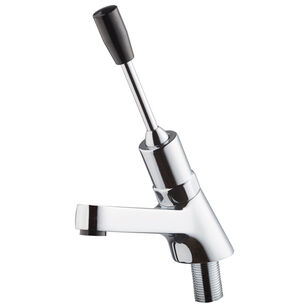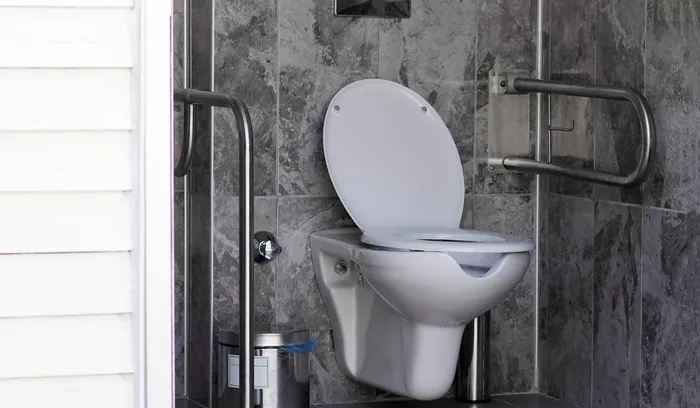Bathroom equipment for people with disabilities

The appropriate equipment for the bathroom for people with disabilities and limited mobility must not only enable the performance of daily activities. Equally important is to ensure maximum independence, privacy and comfort. To achieve this, the equipment for bathrooms for people with disabilities must consist of specialized equipment. Among them are both elements that facilitate the use of individual devices, as well as properly constructed accessories.
How does the equipment for the bathroom for people with disabilities differ from a standard bathroom?
For many people with disabilities, even such daily activities as washing hands or using the toilet can be a challenge. In addition, standard bathroom equipment can increase the risk of accidents for people struggling with balance disorders, mobility difficulties or vision problems. Proper equipment for the bathroom for people with disabilities allows to eliminate most potential hazards.
In addition, the equipment for disabled bathrooms must consist of appliances that are both comfortable to use and do not take up excessive space. This is especially important for people using wheelchairs.
When selecting equipment for a disabled person's bathroom, it is necessary to choose specially designed appliances, such as sinks or toilets. They are characterized by slightly different profiles and dimensions than those for healthy individuals; they are also more resistant to mechanical damage and weight.
How to choose accessories for a disabled bathroom?
When deciding on a specific element of equipment for a bathroom for people with disabilities, it is important to check if it has the necessary certifications and quality standards, which ultimately ensures safety.
Many investors wondering how to choose bathroom accessories for the disabled treat aesthetics as a minor issue. However, this is a serious mistake - being in a nicely decorated interior improves well-being and comfort. Therefore, when choosing individual equipment elements, it is worth getting inspired by current trends and interesting arrangements.
Bathroom accessories for the disabled
Bathroom accessories for the disabled have been designed in such a way as to not only facilitate daily activities, but also to minimize the risk of accidents. This means, among other things, eliminating unnecessary protruding elements and sharp edges.
Every detail is important for the comfort and safety of the user. Bathroom accessories for the disabled also include properly selected bathroom fittings. The best solutions are touchless faucets, which reduce the effort associated with washing hands. An alternative may be single-handle models with long spouts.
A good practice when choosing and installing accessories for disabled bathrooms is also:
- installing handles and handrails in places where support or pulling up is necessary - for example, near the toilet,
- placing special seats, as well as anti-slip mats or suction cups, in shower cabins and bathtubs,
- avoiding any rugs or carpets.
Bathroom mirror for the disabled
Mirrors are an essential element of every bathroom. This also applies to rooms designed for disabled or elderly people. The best bathroom mirrors for the disabled are tilting models, providing the ability to use them freely in any conditions.
In many cases, it is worth supplementing a mirror for the disabled bathroom with additional accessories. For example, if people with dementia are going to use the toilet, it is good to place a railing or other element above it that allows for hanging a towel or curtain. It happens that these people do not recognize their reflection and may be convinced that there is a stranger in the bathroom, which is an extremely stressful experience for them. The possibility of covering the glass allows to avoid such situations.
Bathroom handle for the disabled
A bathroom handle for the disabled is a simple and stable construction that greatly facilitates getting up from the toilet or bathtub. This element can be mounted at any height, on different types of walls.
In places where the wall structure does not allow drilling, bathroom handles for the disabled with suction cups are an excellent solution. Their installation takes only a few seconds, and the load capacity can reach up to several dozen kilograms.
In the case of small spaces for people with disabilities, it is worth installing a tilting bathroom handle. It can be raised and lowered depending on individual needs. This type of handles and supports are a great help in situations where the assistance of another person is necessary for performing hygiene tasks.
Bathroom fixtures for people with disabilities
Bathroom fixtures for people with disabilities should be comfortable and should not require any effort to use. For this reason, models operated by a button or electronic sensor, or a lever, should be taken into consideration.
The same principle applies to bathroom fixtures for people with disabilities, such as shower or bathtub faucets. In addition, the shape and length of individual elements of the fixtures for people with disabilities should be chosen in such a way as to minimize the risk of hitting or snagging, for example, with a piece of clothing on a protruding part.
Shower seats for people with disabilities
Shower seats for people with disabilities are an essential element of cabin equipment. It should be installed in such a way as to allow easy access to the shower faucet. It is also important to place it at the appropriate height, i.e. 43-48 cm. A noteworthy solution is a folding shower seat for people with disabilities. It can be folded at any time, which is a significant convenience in situations where people who do not have trouble standing also use the shower.
For safety, the best choice will always be a shower seat for people with disabilities with a certificate confirming high quality of workmanship and materials. This, in turn, guarantees safety.
Hinged mirrors for people with disabilities
Hinged mirrors for people with disabilities are a solution for a home or public bathroom. They work perfectly in workplaces, hotels, schools, and other public places. Thanks to the mounting on a special, extendable frame, they can be easily tilted at a chosen angle. This means that they can be comfortably used by both people who can stand at the sink and those using wheelchairs. Hinged mirrors for people with disabilities are a convenient option for any toilet - including those used by people without mobility limitations.
Towel bins for people with disabilities
When placing towel and waste bins in a bathroom for people with disabilities, attention should be paid to two aspects. Firstly, their use should not require any effort. Therefore, it is worth avoiding models with flaps or those opened with a button or pedal. Secondly, bathroom bins for towels for people with disabilities should be mounted on the wall - this reduces the risk of the bin being moved or knocked over, creating a tripping hazard or obstructing passage. For convenience, it is best to place them near elements such as towel dispensers or disinfectant dispensers.
Hand dryers for people with disabilities
Bathroom hand dryers for people with disabilities should be touchless. This is important not only for convenience, but also for hygiene - it eliminates the risk of transferring microorganisms between users.
Although there are various models of bathroom dryers available on the market, for people with disabilities it is usually more convenient to use versions with top air flow. It is important to remember to install them at the appropriate height (around 100 cm from the floor) to ensure maximum comfort during use.
Also read:









 Polski
Polski
 Český
Český
 Deutsch
Deutsch
 Spanish
Spanish
 French
French
 Italian
Italian